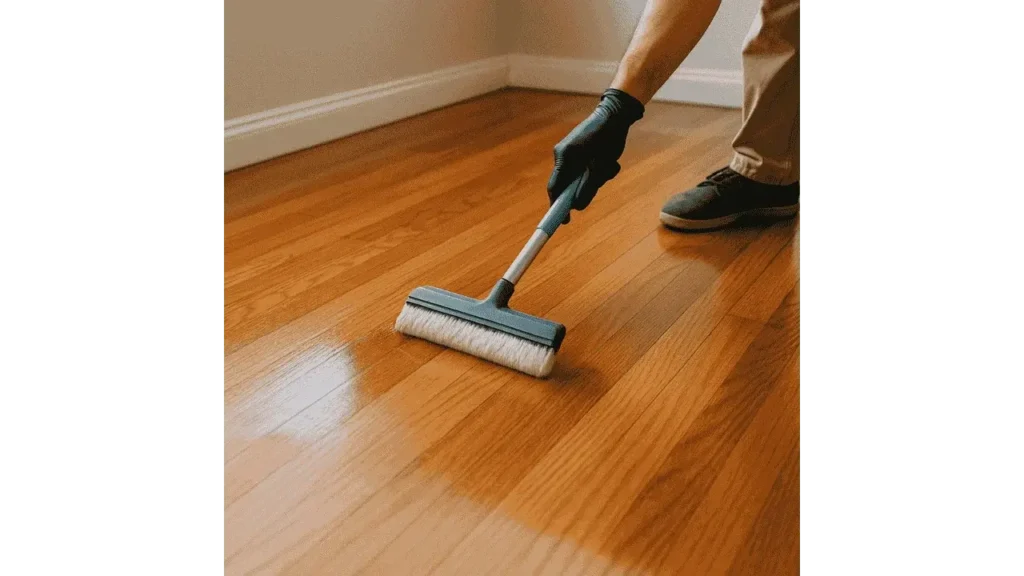Applying polyurethane to hardwood floors is a vital step in preserving their beauty and extending their lifespan. Polyurethane acts as a protective barrier against scratches, stains, and daily wear, leaving your floors with a stunning finish. This comprehensive guide will walk you through the entire process, from preparation to maintenance, ensuring a professional-grade result.

Understanding Polyurethane for Hardwood Floors:
Polyurethane comes in two main types: oil-based and water-based. Oil-based polyurethane provides a warm, amber tone and is highly durable but takes longer to dry. Water-based polyurethane dries faster and has a clear finish, making it ideal for preserving the wood’s natural color. Choosing the right type depends on your desired appearance and durability needs.
Preparing Your Hardwood Floor for Polyurethane Application:
Cleaning and Sanding the Surface
Start by thoroughly cleaning the floor to remove dust and debris. Sand the surface to eliminate old finishes and smooth out imperfections. This step ensures the polyurethane adheres properly.
Choosing the Right Sandpaper Grit
Begin sanding with 36-40 grit for rough areas, followed by 60-80 grit to smooth the surface. Finish with 100-120 grit to prepare the floor for sealing.
Dealing with Stains and Imperfections
Address any stains or dents before applying polyurethane. Use wood filler for gaps and scratches, and sand them down evenly to ensure a smooth finish.
Learn More: Wood Floor Identification
Gathering Your Tools for the Job:
Essential Tools and Materials
You will need polyurethane (oil- or water-based), a high-quality brush or lambswool applicator, sandpaper, a vacuum, tack cloths, and painter’s tape.
Safety Gear for Polyurethane Application
Wear protective gear, including gloves, safety goggles, and a respirator mask, especially when using oil-based polyurethane in poorly ventilated areas.
Choosing the Right Applicator
For oil-based polyurethane, a natural-bristle brush or lambswool applicator works best. For water-based finishes, a synthetic brush or foam roller ensures even coverage.
Applying the First Coat of Polyurethane:
Stirring vs. Shaking Polyurethane
Always stir polyurethane gently to mix the contents evenly without creating air bubbles. Shaking can introduce bubbles that may transfer onto the floor.
Cutting in the Edges
Start by cutting in the edges of the room with a brush, ensuring even coverage along baseboards and corners before rolling out the main area.
Applying Thin, Even Coats
Apply a thin, even coat of polyurethane along the grain of the wood. Work in small sections to maintain a wet edge and avoid lap marks.
Intermediate Sanding Between Coats:
Why Intermediate Sanding Is Crucial? Light sanding between coats ensures proper adhesion and removes imperfections like dust particles or bubbles.
Choosing the Right Sanding Pads: Use a 220-grit sanding screen or fine sandpaper between coats for a smooth finish.
Cleaning Up After Sanding: Vacuum thoroughly and wipe the floor with a tack cloth to remove all dust before applying the next coat.
Applying Additional Coats of Polyurethane: Apply at least 2-3 coats for water-based polyurethane and 2 coats for oil-based. Allow proper drying time between coats as specified on the product label.
Final Touches and Curing: After the final coat, let the floor cure for at least 24-48 hours before light use. For full curing, wait 7 days before moving heavy furniture back into the room.
Special Considerations for High-Traffic Areas:
In high-traffic zones, consider adding an extra coat of polyurethane for added durability. Oil-based finishes tend to last longer in busy areas.
Using Polyurethane on Different Wood Types:
Application on Light vs. Dark Woods: Water-based polyurethane is ideal for light woods to prevent yellowing, while oil-based enhances darker woods with a warm tone.
Special Techniques for Exotic Hardwoods: Exotic hardwoods may require a sanding sealer before applying polyurethane to ensure even absorption.
Considerations for Softwoods: Softwoods like pine absorb finishes more quickly, so extra coats may be necessary for even protection.
Regular Maintenance of Polyurethane-Coated Floors:
Cleaning Tips for Polyurethane Floors: Sweep or vacuum regularly to prevent dirt from scratching the surface. Use a damp mop with a wood-safe cleaner for deeper cleaning.
Dealing with Scratches and Scuffs: Minor scratches can be buffed out with a fine abrasive pad, while deeper marks may need spot refinishing.
When to Reapply Polyurethane? Depending on wear, floors may need recoating every 3-5 years to maintain protection and appearance.
Conclusion:
Applying polyurethane to hardwood floors is a rewarding project that enhances their appearance and protects them from daily wear. By carefully preparing the surface, using the right tools, and applying multiple thin coats, you can achieve a beautiful, long-lasting finish. Regular maintenance will keep your floors looking stunning for years to come.
